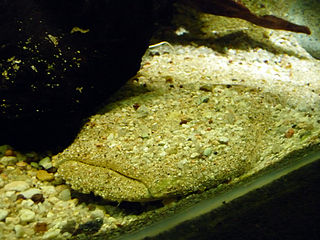
The Pseudopimelodidae are a small family of catfishes known as the bumblebee catfishes or dwarf marbled catfishes. Some of these fish are popular aquarium fish.

Farlowella acus is the type species of the armored catfish genus Farlowella. Members of this genus are commonly known as twig catfish or whiptail catfish. The specific name of the species, acus, means “pointed” or a “needle” or “spine”.

Calophysus macropterus is a species of catfish of the monotypic genus Calophysus of the family Pimelodidae.

Pseudopimelodus is a genus of catfishes of the family Pseudopimelodidae.
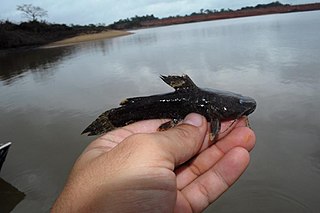
Batrochoglanis is a small genus of catfishes of the family Pseudopimelodidae.

Hyalobagrus is a genus of bagrid catfishes found in Southeast Asia.

Leiarius is a genus of long-whiskered catfishes native to South America. Most of the genus' species are found in the aquarium hobby as ornamental fish.

Gagata is a genus of sisorid catfishes native to Asia.
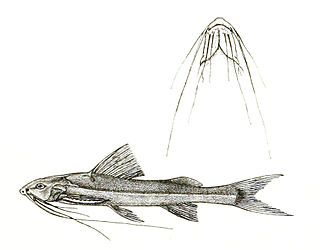
Nangra is a genus of sisorid catfishes native to Asia.
Pseudostegophilus is a genus of pencil catfishes native to rivers in tropical South America. The members of this genus are obligate parasites that feed on scales and mucus of other fish.

Paraplotosus is a genus of catfishes native to Australasia and South-east Asia.
Porochilus is a genus of eeltail catfishes native to Australia and New Guinea.
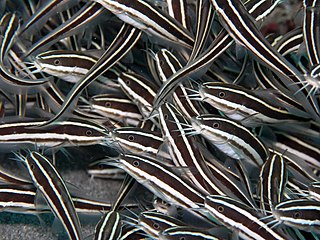
Plotosus is a genus of eeltail catfishes native to the Indian Ocean, the western Pacific Ocean and New Guinea.

Belodontichthys is a genus of sheatfishes native to Asia.
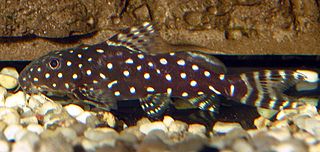
Synodontis angelicus is a species of upside-down catfish commonly named polkadot squeaker, black clown catfish, whitespotted squeaker, pearl squeaker, or angel squeaker. This species is native to the Congo Basin in the Democratic Republic of the Congo and the Republic of the Congo. It was originally described in 1891 by Belgian ichthyologist Louise Schilthuis after its discovery in the Malebo Pool of the Congo River. The specific name "angelicus" means heavenly or divine, since juveniles of this species are remarkable for their bright coloring.
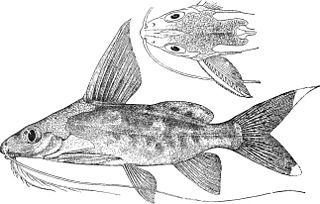
Synodontis alberti, the bigeye squeaker, Albert's syno, bigspotted squeaker, or high-fin synodontis, is a species of upside-down catfish native to the Congo Basin of Cameroon, the Democratic Republic of the Congo and the Republic of the Congo. It was originally described in 1891 by Belgian ichthyologist Louise Schilthuis after its discovery in the Malebo Pool of the Congo River.

Pimelodus pictus, also known as the pictus cat or pictus catfish, is a small member of the catfish family Pimelodidae, native to the Amazon and Orinoco river basins and commonly kept as a pet in freshwater aquariums. Pictus catfish are sometimes mislabeled as Angelicus cats in the aquarium trade, but the latter name actually refers to an unrelated African catfish, the mochokid Synodontis angelica.
Chaetostoma lineopunctatum is a species of catfish in the family Loricariidae. It is native to South America, where it occurs in the basins of the Aguaytía River, the Pachitea River, and the Pisqui River in the Ucayali River drainage in Peru. The species reaches 14.3 cm SL. It appears in the aquarium trade, where it is referred to as the bloodfin bulldog pleco or by its L-number, which is L-276.
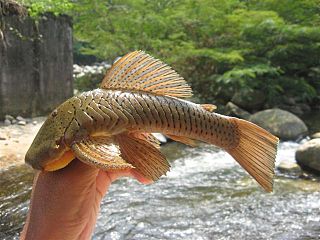
Chaetostoma milesi is a species of catfish in the family Loricariidae. It is native to South America, where it occurs in the basins of the Magdalena River and the Apure River. The species reaches 13 cm SL. It appears in the aquarium trade, where it is most frequently referred to as either the bulldog pleco or the rubbernose pleco.
Peckoltia lineola is a species of catfish in the family Loricariidae. It is native to South America, where it occurs in the basins of the Ventuari River in Venezuela and the Inírida River in Colombia. The species reaches 9.7 cm SL and is typically found in rocky riffles. Its specific epithet, lineola, derives from a Latin word meaning "line", referring to the lines present on the species' compound pterotic.















